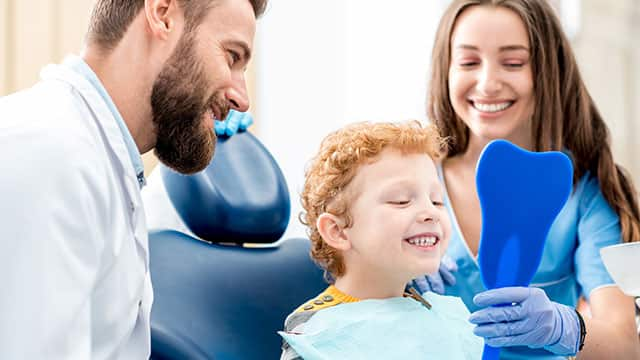The Definition of Dentofacial Orthopedics
“Dento” stands for teeth and “facial” for the face. Dentofacial orthopedics is a specialty that treats both the teeth and the facial structure including the jaw that provides structure to teeth.
About This Specialty
Dentofacial orthopedics is one of twelve recognized dental specialties which requires advanced education, practice, and research. The dentofacial orthopedics methods are usually applied to children before orthodontic treatment or braces, as these tools can help guide jaw development during growth.
The Jawbones: Defining Your Smile
As a child grows, both the maxilla (upper jaw) and mandible (lower jaw) will grow in three dimensions. This growth determines the final positioning of the mid and lower face, as these bones connect to the sinuses, the bottom of the nose, and cheekbones. According to The Mayo Clinic, jaw growth typically stops between 14 to 16 years for women and ages 17 to 21 years for men.
Sometimes, the upper and lower jaws will grow at different rates and sizes, creating alignment issues between the upper and lower teeth. Ideally, the upper jaw should have a more forward position and be wider than the lower jaw. Underbites (where the mandible protrudes), overbites (where the maxilla protrudes), and other occlusion or bite problems may also be caused by breathing difficulties and thumb sucking.
Identifying Growth Problems
While a medical professional can identify a child’s jaw malformations as early as birth, mixed dentition (where some baby teeth are still present and adult teeth have begun to grow in) is a pivotal moment to detect a jaw growth problem. Occurring between ages seven and nine, this is a crucial time for dental professionals to determine whether intervention or close monitoring is necessary as the mouth and jaws grow. The dentist may refer your child to an orthodontist to take impressions and three-dimensional scans of their mouth to make a proper diagnosis and treatment plan.
Dentofacial Orthopedic Appliances
If a child's bite problems require intervention, an orthodontist can use various appliances to change the rate, direction, or amount of jaw growth. Some of the more common appliances that dental professionals may recommend are:
Palate expander. This fixed device slowly pushes the cartilage above the upper jaw apart to widen a maxilla that is too small to hold the teeth.
Lower jaw expander. Because the lower jaw’s bone can't be stretched, this expander gradually moves the teeth apart to make room.
Activators. These devices have been used since the 1930s to gradually move the upper or lower jaws forward while guiding erupting teeth.
Block. A fixed bite block uses the bite force to gradually and comfortably move teeth and correct malocclusion.
Orthodontic headgear. For bite problems that orthodontists can’t correct from inside the mouth, an appliance that straps around the face to apply forces to the jaw and head may be recommended.
Before or after an orthodontist uses one of these appliances to correct jaw position, they may also fit a patient for ordinary braces to correct tooth positioning and align how the teeth fit together.
Can Adults Benefit from Dentofacial Orthopedics?
Jaw problems that aren’t corrected in childhood may not cause discomfort in adulthood but often cause speech difficulties, uneven wear, damage to teeth, and TMJ problems. While an adult who wants to correct their bite will not have the same range of options as a child who is still growing, there are still solutions available for those who want to change their smile later in life. Dentofacial orthopedics for adults may involve procedures like jaw surgery, also known as orthognathic surgery.
Dental Evaluation
The American Association of Orthodontists recommends that children first visit an orthodontist no later than age seven – which is also an ideal age for dentofacial orthopedic work. But if you think your child might be experiencing jaw malformations or issues earlier, reach out to your medical or dental professional for an evaluation. Even if you believe their smile is perfect the way it is, early diagnosis and treatment can have a lasting improvement on appearance and function.
Every child deserves to have a healthy smile. Sometimes, you may need to turn to early intervention to ensure that this happens. Luckily, your dental professional will be able to determine any jaw growth issues during your child’s regular dental checkups. And the sooner your child can get dentofacial orthopedic treatment, the more likely they are to have a healthy jaw—and smile—for life.
FAQ
Is there a difference between periodontics and orthodontics?
Yes, periodontics and orthodontics are two different specialties. There are many parts of the mouth and specialists that address different areas or concerns.
What is the difference between periodontics and orthodontics?
Periodontics refers to the treatment of gums. A periodontist will assess the health of your gums and treat conditions such as gingivitis that may lead to tooth loss. Orthodontic treatment is used to align teeth. Misaligned teeth can cause issues with plaque buildup and staining and affect one’s bite. If a bite is off it can impact molars and damage teeth or cause jaw problems later on.
What is the difference between an orthopedic and an orthodontic treatment?
Orthopedic treatment deals with the structure of the jaw and facial bones that house teeth and corrects any development issues. These concerns may be addressed before orthodontic treatment which corrects bite alignment and the cosmetic appearance of teeth. These treatments may go hand in hand.
Oral Care Center articles are reviewed by an oral health medical professional. This information is for educational purposes only. This content is not intended to be a substitute for professional medical advice, diagnosis or treatment. Always seek the advice of your dentist, physician or other qualified healthcare provider.
ORAL HEALTH QUIZ
What's behind your smile?
Take our Oral Health assessment to get the most from your oral care routine
ORAL HEALTH QUIZ
What's behind your smile?
Take our Oral Health assessment to get the most from your oral care routine















